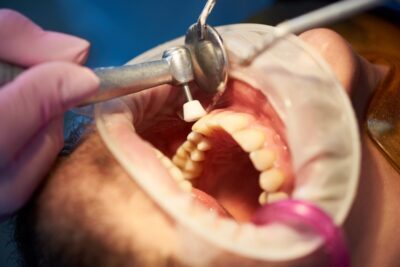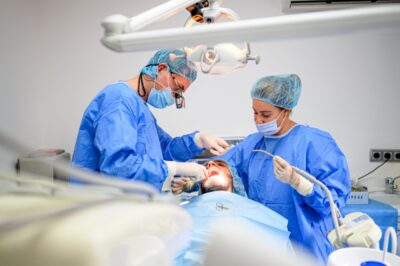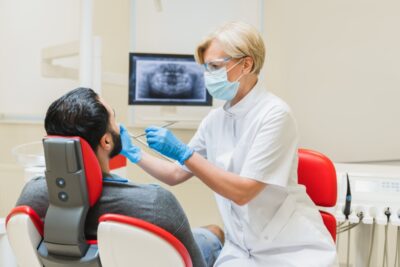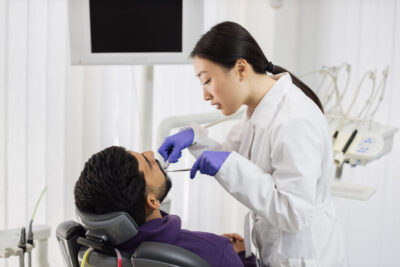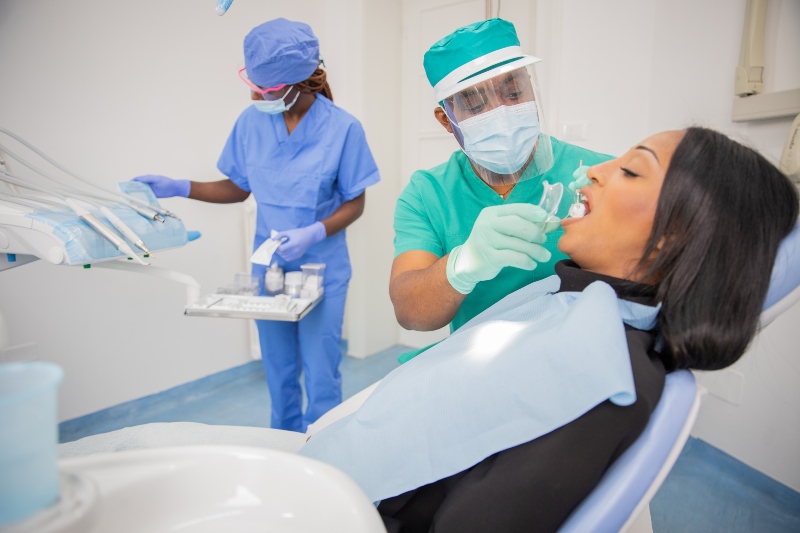
When it comes to good oral hygiene, healthy gums are arguably just as important as healthy teeth. Your gum tissues are both delicate and instrumental in preserving your oral health. Therefore, any untreated issues with gums can cause health problems down the road, including and especially gum disease.
Gum disease or periodontal disease is one of the most common issues your dental hygienist may detect in a routine office visit. Moreover, advanced periodontal disease (again, if left untreated) can affect the soft tissue around your teeth, the affected teeth themselves, and even throughout your body. Advanced periodontal disease or advanced periodontitis can lead to other lifelong health problems. These health problems include bacterial infection that spreads and heart disease.
According to the Centers for Disease Control and Prevention, 47.2% of adults aged 30 years and older have some form of periodontal disease, and the risk for periodontal disease increases with age. In fact, according to recent estimates, 70.1% of adults 65 years and older have some form of periodontal disease.
However, a heightened risk of advanced periodontal disease isn’t necessarily a reason to panic. Risk factors for periodontal disease can be mitigated well before the early signs of periodontal disease become problematic. Additionally, advanced periodontitis or severe periodontitis can be addressed with the proper disease treatment.
The key is to recognize the early stages of periodontal disease. Then, you can take the right measures to prevent advanced gum disease and understand the different nonsurgical and surgical treatments that are readily available.
Table of Contents
What Are the Stages of Periodontal Disease?
What Are the Early Signs and Symptoms of Gum Disease?
What Are the Gum Disease Risk Factors?
How Long Can You Keep Your Teeth with Periodontal Disease?
Diagnosis of Advanced Periodontal Disease
Overview of Different Treatments for Advanced Periodontal Disease
Tips for Preventing and Addressing Advanced Periodontal Disease
What is Advanced Periodontal Disease?
Advanced periodontal disease goes by different names, including advanced gum disease and advanced periodontitis. This all refers to gum inflammation and infection of the soft tissue around your teeth.
The harmful bacteria or bacterial plaque around your teeth can cause irritation, leading to redness, swelling, and/or bleeding gums. These early signs of gum disease are collectively called gingivitis. The diseased gum tissue can eventually lead to tooth loss.
What Are the Stages of Periodontal Disease?
While every patient is different, with varying risk factors that can dictate how quickly gum disease progresses, the different stages of periodontal disease include the following.
Periodontal Disease Stages
Gingivitis
This is the first stage of gum disease, and it starts with red and puffy gum tissue that may bleed when cleaned with brushing or dental floss. There is no bone loss or tooth loss at this stage, and gingivitis is reversible with the proper gum disease treatment.
Mild periodontitis
At this second stage of gum disease, bacteria has seeped beneath the gum tissue, which may impact the supporting bone and hinder bone growth. The gum tissue may start to pull away from the affected teeth and the gum line, resulting in noticeable gum pockets.
Moderate periodontitis
At this stage, and assuming there has been no periodontal disease treatment, the bacteria will erode the ligaments, the soft connective tissue, and the bone that holds your teeth in place. Noticeable signs of gum disease start to occur at this stage, including bad breath and infection or pus around the gum line. You may also notice receding gums and pain around the root surfaces when brushing, using dental floss, or simply periodically and in general. Swollen gums, lost gum tissue, loose teeth, and gum recession are all possible during these more advanced stages of periodontal disease, and a more substantial disease treatment may be required. However, nonsurgical treatment options may still be available.
Advanced periodontitis
In the late stages of periodontal disease, bleeding gums, bad breath, gum recession, and bone loss continue, which may result in loose teeth and tooth loss in the affected area. If the bone loss around the teeth is severe due to infection, reversing advanced periodontal disease may be challenging, if not impossible. Therefore, your dentist will know how to effectively treat your bone loss, tooth loss, and disease through advanced periodontal disease treatment.
What Are the Early Signs and Symptoms of Gum Disease?
The early signs and symptoms of gum disease may be identified well before advanced periodontitis occurs. These symptoms include the following:
- Swollen gums
- Discolored gums that are bright red, dark red, or dark purple
- Gum tissue that feels tender when brushed or touched
- Bleeding gums or signs of blood on your toothbrush or in the sink after brushing or flossing
- Persistent bad breath Bacteria or noticeable puss near the gum tissue or tooth roots
- Loose teeth or tooth loss
- Pain when chewing, brushing, or flossing
- Gaps between the affected teeth that look like black triangles
- Gum tissue that separates from your teeth, also known as receding gums, which make your teeth look longer
- Alterations in how your teeth fit together when you bite or chew
What Are the Gum Disease Risk Factors?
Anyone can be at risk of gum disease, even those who embrace improved oral hygiene. However, a few gum disease risk factors or causes will make a dental patient more susceptible to advanced periodontal disease.
These advanced periodontal disease risk factors include the following:
- Smoking or chewing tobacco
- Pre-existing gingivitis
- Poor oral health care habits, like not regularly seeing a dental hygienist for a professional dental cleaning.
- Hormonal changes for women, such as changes during pregnancy or menopause.
- Recreational drug use that affects gum tissue and oral health, like smoking marijuana or vaping.
- Obesity can result in multiple health issues, including poor periodontal health.
- Stress may include habits like teeth grinding or teeth clenching.
- Nutrition issues, including not getting enough vitamin C.
- Genetics and having family members with severe gum disease.
- Certain medicines or oral antibiotics cause dry mouth or gum tissue changes.
- Existing health conditions that lower immunity, such as leukemia, HIV/AIDS, heart disease, and cancer.
- The presence of certain other diseases, such as diabetes, rheumatoid arthritis, and/or Crohn’s disease.
How Long Can You Keep Your Teeth with Periodontal Disease?
While tooth loss is a concern, the good news is that treatment is available for gum disease – even advanced gum disease. Therefore, you may be able to maintain healthy bone while mitigating side effects like bad breath and bleeding gums.
Your periodontal disease treatment expert will be able to explain your different options to treat gum disease and prevent bone loss and tooth loss.
Diagnosis of Advanced Periodontal Disease
Your dentist may use various techniques and tools to identify advanced periodontal disease, such as pain-free methods.
- Reviewing your medical history – Your medical history will highlight any factors that could be linked to advanced periodontal disease, such as smoking or taking certain oral antibiotics that cause dry mouth.
- Conducting an exam – Your dentist will examine your mouth to look for bacteria, plaque, and tartar buildup, as well as other signs like damaged tooth roots, bleeding gums, or other issues with your gum tissue and natural bone.
- Taking measurements – Your dentist may also measure how deep the pockets are between your gum tissue and teeth by placing a tiny ruler called a dental or periodontal probe between your teeth and your gum line. Pockets in your mouth that are deeper than 5 mm cannot be cleaned well with routine care, and advanced treatments may be warranted.
- Taking X-rays – Your dentist may also take X-rays to check for signs of tooth loss or bone loss in areas with deeper pockets.
Overview of Different Treatments for Advanced Periodontal Disease
There are many different treatments available for gum disease. These treatments range from taking oral antibiotics to scaling and root planing to having a more advanced surgical procedure. These treatments for gum disease include the following.
Nonsurgical Treatments for Gum Disease
If your periodontitis isn’t too advanced, you may be a candidate for the following nonsurgical treatment options.
Scaling
Scaling is a procedure that removes plaque, tartar, and bacteria from your tooth surfaces and below your gumline. It is a painless cleaning procedure that may be conducted using standard dental instruments such as a laser, or even an ultrasonic device.
Root planing
Root planing is a procedure that smooths the surfaces around your tooth roots. Additionally, root planing helps prevent further buildup of bacteria around the gum line and allows gum tissue to reattach to any loose teeth.
Topical or oral antibiotics
Oral antibiotics can help control bacterial infection, while topical antibiotics like mouth rinses or gels can be directly applied to gum pockets. Both options have limited side effects and are easy to administer. Antibiotics, scaling, and root planing are all simple procedures that can be used to treat gum disease before it morphs into advanced periodontitis. If you are diagnosed with advanced periodontal disease, then the following surgical treatments may be recommended.
Surgical Treatments for Gum Disease
When it comes to advanced gum disease, a surgical procedure may be deemed the best and most effective treatment to improve your oral health.
Your oral surgeon will help you determine the best procedure for your individualized needs and present oral health issues. However, these surgical treatments may include the following procedures.
Flap surgery
Flap surgery, also called pocket reduction surgery, is a standard surgical procedure for advanced gum disease. During flap surgery or pocket reduction surgery, your periodontist or oral surgeon will make cuts into your gums and carefully fold back the gum tissue to make any adjustments. The underlying and existing bone may be reshaped before the gum tissue is stitched back into place, creating an overall healthier gum line and a better smile.
Soft tissue grafts or gum grafts
When you lose gum tissue, the gum line lowers, which can expose your tooth roots. As a result, some of this damaged, unwanted tissue will need to be reinforced, which is done through soft tissue grafts, also known as gum grafting or a gum graft. In this procedure, a small amount of tissue is often removed from the roof of your mouth or another source before it is attached and affixed to the affected site. The result is a reduction in future gum loss and a better aesthetic appearance from the inside out.
Bone grafting
Bone grafting is a surgical procedure performed when the advanced periodontal disease has destroyed the bone surrounding your tooth roots. A bone graft can be created from your own bone or a synthetic bone. Either way, a bone graft helps to hold your teeth in place, preventing further tooth loss. Bone graft can also help with the regrowth of natural bone, mitigating the long-term effects of advanced periodontitis.
Guided tissue regeneration
Guided tissue regeneration allows for the regrowth of tissue and bone that bacteria may have damaged during the late stages of gum disease. In guided tissue regeneration, your dentist or oral surgeon may place a special fabric between your existing bone and tooth. This material keeps unwanted tissue from growing into the affected healing area, allowing only natural bone to grow back in place.
Tissue-stimulating proteins
Another treatment entails adding tissue-stimulating proteins – typically in the form of a special gel – to the diseased tooth roots to stimulate the growth of healthy gums and tissue.
Remember that the above nonsurgical and surgical treatments for advanced gum disease are just the tip of the iceberg. Gum disease can take many forms and can affect patients in different ways, so your best resource is your periodontics expert.
A consultation with Pannu Dental Group is the best first step to determine the optimal way to proceed for your unique oral health needs.
Tips for Preventing and Addressing Advanced Periodontal Disease
When it comes to advanced periodontal disease, prevention steps can go a long way. However, even advanced gum disease can be effectively treated with the best periodontic dental group available.
Tips for preventing periodontal disease include the following:
- Maintain great oral health – Advanced periodontal disease begins with the bacteria found in the plaque that builds up on your teeth, so great oral hygiene habits – including brushing and daily flossing – will go a long way towards gum disease prevention.
- See your dental hygienist regularly – Schedule regular check-ups and cleanings with your dentist twice a year, which can help identify any signs and symptoms of gum disease before it transitions into advanced periodontitis.
- Adopt healthier lifestyle habits – Enlisting healthier across-the-board habits, like eating better or quitting smoking, will also erase some risk factors that naturally lead to advanced periodontitis.
Our Bay Area Periodontics Can Provide the Best Treatment Possible
From laser therapy for gum disease to periodontal cleaning, an expert in periodontics will be able to address existing advanced periodontal disease effectively. Our expert dentist can guide you to prevent advanced periodontitis before it becomes a life-altering problem.
This is where Pannu Dental Group shines. With our team of experts and the most advanced technology available when it comes to treating advanced periodontitis, Pannu Dental Group is your best resource for gum disease prevention, education, and treatment.
Take an important first step to maintaining your oral health and smile for decades to come. With our client-focused care, you can rest assured that you are in the best and most experienced hands possible to maintain and enhance all aspects of your oral health.
Reach out to us today for a consultation or a periodontal cleaning.

Dr. Dalvir S. Pannu has been a practicing dentist since 1995. In 1996 he opened his first dental practice in India, where he gained invaluable experience and acumen. In October of 1997 he was invited by the American Dental Association (ADA) to present the table clinic on Endodontics, at their annual session held in Washington, D.C. At this time he fell in love with the United States and became passionate about practicing dentistry in California. He became particularly enamored of the San Francisco Bay area, and soon took up residence and work here.

